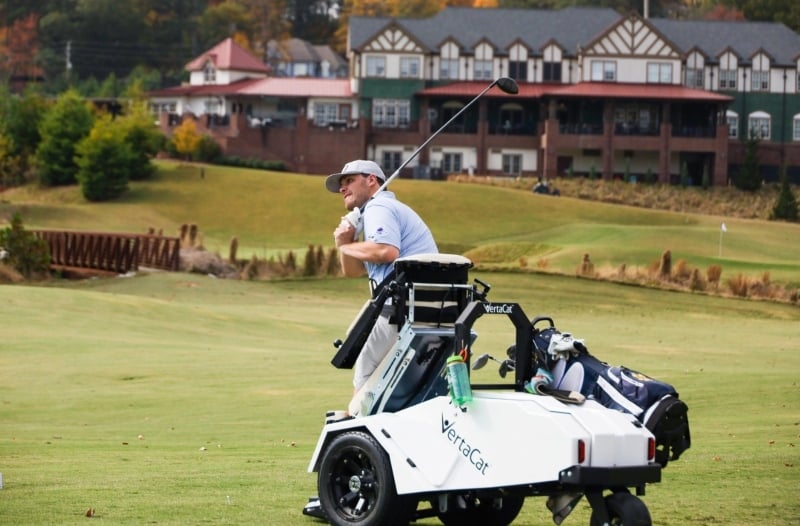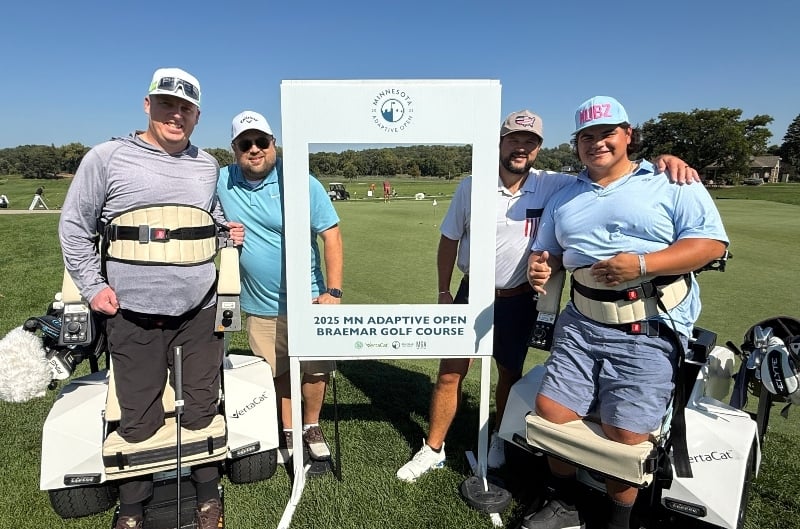Back in the Game: Skylar Miller's VertaCat Story
Skylar Miller golfed his entire life. Then, a spinal cord tumor changed everything.
3 min read
VertaCat Jul 7, 2025 10:00:00 AM
.webp)
Pain usually has a timeline. You get hurt, you heal, you move on. Chase Bradshaw understood this rhythm–after 21 years as a professional freestyle motocross rider, he'd broken bones, pushed through injuries, and always bounced back.
But this time was different.
"I don't think it was until I got to rehab that I even realized how severe this injury was," Chase remembers. "The first week goes by and you're in so much pain, they have you on so many drugs and doing surgeries that you don't understand what's going on. But by the time you get to rehab and you've talked to other people going through this, that's when it really hits you."
Chase was diagnosed with a T12 spinal cord injury, but those clinical words couldn't capture the totality of what had been stolen from him.
"Nobody tells you the whole truth," Chase says. "They'll say you're never going to walk again, and that seems to be everybody's answer. But nobody will tell you, 'Hey, you're going to be in constant pain,' or 'Hey, you're not going to feel anything,' or 'Your legs are going to go into spasms all throughout the day.'"
The uncertainty was perhaps the hardest part. A hundred thousand people could break their backs in the exact same spot, the exact same way, and have different outcomes. For someone used to controlling his body with precision, not knowing was unbearable.
"When you first get hurt, you think that your life is over, that you're not going to be able to do anything anymore," Chase admits. "You have to completely relearn how to enjoy life and believe in what is possible."
Chase faced the hardest battle of his life–the battle to find a reason to keep fighting.
As the months passed and the initial shock gave way to a new reality, something unexpected began to happen.
"Before this injury, I was kind of hyperfixated on getting a bigger house or having a super badass car, being able to push my job or career as far as possible," Chase recalls. "What I tell people all the time is what this injury taught me is really what's important in life."
The man who once measured life in adrenaline rushes and achievement milestones found himself discovering a completely different set of values.
"There was the life before my injury which I would almost describe as very individual, all about you," he explains. "When you go through an injury like this, you realize that life is about your relationships and all the other people in your life. It's a lot bigger than just you."
His relationships became his lifelines. The quiet moments with his three children became more precious than any trophy. The friends who showed up day after day reminded him that success had nothing to do with what you could do alone.
"I tell people that I get to live two lives inside this one, which is kind of cool," Chase says with a perspective that can only come from losing everything and finding something better on the other side.
And while he may never have chosen this path, Chase discovered that sometimes the life you didn’t want teaches you exactly what you needed to learn.
As Chase began exploring what was still possible, golf unexpectedly reentered his life. Through the VertaCat—a specialized standing wheelchair—he discovered that adaptive sports offered more than just physical activity.
"Whether or not I love golf and want to become the next Tiger Woods or Scottie Scheffler, that's not the point," Chase explains. "The point is really improving my health and being able to get outside and do stuff with people and join that community."
But the VertaCat's impact extended far beyond the golf course. It restored something Chase didn't even realize he'd been grieving.
"The number one thing I like doing in my VertaCat is being able to give my loved ones hugs standing up," he shares. "It's something that everybody takes for granted–just being able to give somebody a proper hug."
At a fundraising golf tournament, Chase first demonstrated the VertaCat. And in the crowd of supporters was the person whose opinion mattered most.
"We were at the tournament and the very first time I got in the VertaCat, my daughter ran up to me and said, 'Daddy, you're standing.' She ran up to me and I was actually able to pick her up and hold her again. She's three," Chase says. "That changed my life."
From those first nights when Chase thought his life was over to standing on a golf course surrounded by friends, his story revealed a truth: limitations are often more mental than physical.
"In my personal opinion, you can still do everything–just do it differently," Chase says. The man who thought he'd lost everything learned he'd only lost one way of doing things.
Golf wasn't just golf anymore, it was a lesson in perspective. Standing in the VertaCat, swinging a club, connecting with others who understood, these moments proved that reinvention was possible at any stage of life.
But perhaps the most powerful truth Chase shares is about time and healing.
"The further away from your injury you get, you realize that life is still enjoyable, that you're able to do anything," he reflects. "And learning how to enjoy it from a different perspective is the one thing that gets better the further away from the injury you get."
Chase Bradshaw thought paralysis meant the end of his story. But it became the beginning of a richer chapter, one where hugs mean more and relationships run deeper. He may navigate the world differently now, but he's proof that different doesn't mean less. Sometimes, different means more than you ever imagined possible.

Skylar Miller golfed his entire life. Then, a spinal cord tumor changed everything.
.jpg)
At The Loop Golf Course in Chaska, Minnesota, adaptive access was baked into the blueprint. Today, three VertaCats serve golfers who travel from...

The Minnesota Golf Association (MGA) hosted Minnesota’s first Adaptive Open in September at Braemar Golf Course in Edina. The three-day event...